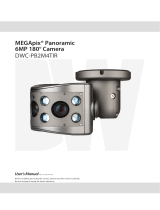
iii
CONTENTS
1. Introduction .................................................................................................................................... 1
2. Physical Description ....................................................................................................................... 2
2.1. Dimensions ....................................................................................................................................... 2
3. Features ........................................................................................................................................... 3
4. Installation ...................................................................................................................................... 4
4.1. Packing List ....................................................................................................................................... 4
4.2. Optional Accessory .......................................................................................................................... 4
4.3. Cables ............................................................................................................................................... 5
4.4. Lens Installation and Adjustment .................................................................................................... 6
4.4.1. Mounting and Wiring .......................................................................................................... 6
4.4.2. Inserting a Micro SD Card .................................................................................................... 9
5. Accessing the User Interface ...................................................................................................... 10
5.1. Checking the Dynamic IP Address .................................................................................................. 10
5.2. Settings for Microsoft Internet Explorer ........................................................................................ 14
5.3. Connecting the Camera to the Network ........................................................................................ 15
5.4. Live View Window .......................................................................................................................... 17
6. Playback ......................................................................................................................................... 23
6.1 Remote Playback Using Playback Page .......................................................................................... 23
6.2 Setting up the Playback Function ................................................................................................... 25
6.2.1. Inserting / Removing the micro SD Card ........................................................................... 25
6.2.2. Testing the Playback Function ........................................................................................... 26
7. Settings .......................................................................................................................................... 28
7.1. System Settings .............................................................................................................................. 29
7.1.1. Network ............................................................................................................................. 29
7.1.2. Date / Time ........................................................................................................................ 35
7.1.3. Storage .............................................................................................................................. 36
7.1.4. Display and Overlay ........................................................................................................... 38
7.1.5. System Maintenance ......................................................................................................... 40
7.1.6. System Information ........................................................................................................... 43
7.1.7. User ................................................................................................................................... 44
7.1.8. Black / White List ............................................................................................................... 46
7.1.9. Serial Communication ....................................................................................................... 47
7.2. Camera Settings ............................................................................................................................. 48




















